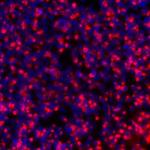
Research Topics
The root of Dr. Zhuang’s research is based on the inherited and somatic mutations that result in cancer. He aims to understand how these mutations contribute to the development and progression of tumors, particularly in brain tumors. His Cancer Stem Cell Biology Research Program at the Neuro-Oncology Branch (NOB) utilizes clinical, translational, and basic approaches to study the basic science as a foundation for understanding the pathological changes present in tumors. He has three ongoing multidisciplinary projects: 1) investigating hypoxia signaling and tumor development, 2) examining the impact of patient-derived IDH1 mutant mosaicism on brain tumor development, and 3) developing therapeutics for cancers of the central nervous system.
The first project investigates gain-of-function mutations in the gene encoding the hypoxia inducible factor 2α (HIF2α) protein, which was first found in a combined clinical and scientific effort culminating in the discovery of Pacak-Zhuang syndrome. Using mouse models, Dr. Zhuang’s lab is investigating the unusual phenotypes recently identified in patients with Pacak-Zhuang syndrome, including sexual dimorphism and HIF2α genomic imprinting. These studies will substantially advance our understanding of HIF2α’s impact on biology and pathobiology, including Pacak-Zhuang syndrome and hypoxia signaling in brain tumors.
The second project began with a critical observation in identical twins with low-grade IDH-mutant gliomas. This observation showed that an IDH1 mutation in early development can have two possible outcomes: 1) it may remain quiescent or in the “pre-tumor state” throughout development, or 2) it may acquire additional mutations that allow the cell to transform into a tumor. Because Dr. Zhuang discovered glutamine synthetase, which is important in IDH-mutant tumors (and astrocytoma specifically), his lab is primed to deduce the basic physiology resulting in a brain tumor. His team used deep PCR techniques to show that an inherent and embryonic IDH1 mutation triggered a tumor with p53. His lab has also used induced pluripotent stem (iPS) cells to determine how IDH mutations drive tumor growth by studying the 2-hydroxyglutarate (2-HG) and glutamate cycle.
The third project has several arms: First, Dr. Zhuang’s lab is working to develop an immunomodulator called LB100, which acts by inhibiting protein phosphatase 2A and has entered clinical trials. Second, his lab has developed CAR-T cells targeting the hypoxia signaling downstream product, carbonic anhydrase IX. Third, he has developed a modulator of HIF2a, which has allowed to his lab to further explore this pathway.
Biography
Dr. Zhuang received his Doctor of Medicine degree from Shanghai Jiao Tong University School of Medicine (formerly Shanghai Second Medical University) in China. He completed a short residency in general surgery at Ruijin Hospital before moving to the United States to pursue a Ph.D. in pharmacology at Wayne State University in Detroit, Michigan. Following his doctorate, he was a postdoctoral fellow at Massachusetts General Hospital for a year. Shortly thereafter, he relocated back to Michigan to be a resident in translational medicine at Henry Ford Hospital. He then served as a research associate at the University of Michigan, and moved to NIH in 1993 as a resident in anatomic physiology at NCI’s Department of Pathology. He was named a special expert and staff pathologist for the Surgical Neurology Branch—a position he held for seventeen years. In 2017, Dr. Zhuang joined the Neuro-Oncology Branch (NOB) as a senior investigator and head of the Cancer Stem Cell Biology Research Program.
In addition to his extensive research experience and tenure in multiple branches at NIH, Dr. Zhuang is also licensed to practice medicine in the District of Columbia, and holds a completion certificate for an anatomic pathology residency. He also currently holds five patents (11 pending) that highlight the novelty of his research endeavors.
Honors, Awards and Leadership
- The Federal Technology Transfer Award, 2019
- The Federal Technology Transfer Award, 2018
- Cy Katzen Humanitarian Award, 2014
- Federal Laboratory Consortium Award for Excellence in Technology Transfer, 2010
- NIH APAO Outstanding Achievement Award, 1999
- Gordon F. Vawter Award, Society for Pediatric Pathology, 1996
- NCI New Invention and Technology Development Award, 1995
- American Society of Clinical Pathologists Resident Award in Anatomic Pathology, 1994
- Stowell-Orbison Award for Pathologist-in-training, U.S. and Canadian Academy of Pathology, 1994
Patents
- Isolation of cellular material under microscopic visualization using an adhesive/extraction reagent tipped probe, US Patent #5843644
- Isolation of cellular material under microscopic visualization, US Patent #6010888
- Isolation of cellular material under microscopic visualization, US Patent #6204030
- Isolation of cellular material under microscopic visualization, US Patent #6569639
- The gene associated with Multiple Endocrine Neoplasia type 1, menin polypeptides, and uses thereof, US Patent # 7358347
Selected Publications
- Gordon IK, Lu J, Graves CA, Huntoon K, Frerich JM, Hanson RH, Wang X, Hong CS, Ho W, Feldman MJ, Ikejiri B, Bisht K, Chen XS, Tandle A, Yang C, Arscott WT, Ye D, Heiss JD, Lonser RR, Camphausen K, Zhuang Z. Protein Phosphatase 2A Inhibition with LB100 Enhances Radiation-Induced Mitotic Catastrophe and Tumor Growth Delay in Glioblastoma. Mol Cancer Ther. 2015;14(7):1540-1547.
- Yang C, Swallows CL, Zhang C, Lu J, Xiao H, Brady RO, Zhuang Z. Celastrol increases glucocerebrosidase activity in Gaucher disease by modulating molecular chaperones. Proc Natl Acad Sci U S A. 2014;111(1):249-54.
- Pacak K, Jochmanova I, Prodanov T, Yang C, Merino MJ, Fojo T, Prchal JT, Tischler AS, Lechan RM, Zhuang Z. New syndrome of paraganglioma and somatostatinoma associated with polycythemia. J Clin Oncol. 2013;31(13):1690-8.
- Zhuang Z, Yang C, Lorenzo F, Merino M, Fojo T, Kebebew E, Popovic V, Stratakis CA, Prchal JT, Pacak K. Somatic HIF2A gain-of-function mutations in paraganglioma with polycythemia. N Engl J Med. 2012;367(10):922-30.
- Lu J, Kovach JS, Johnson F, Chiang J, Hodes R, Lonser R, Zhuang Z. Inhibition of serine/threonine phosphatase PP2A enhances cancer chemotherapy by blocking DNA damage induced defense mechanisms. Proc Natl Acad Sci U S A. 2009;106(28):11697-702.
Related Scientific Focus Areas
This page was last updated on Friday, June 28, 2024




